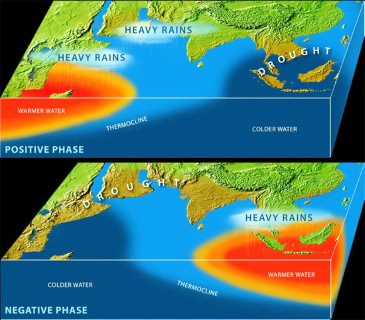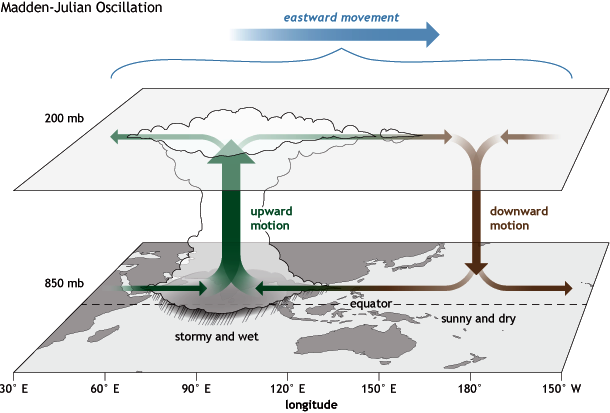Geography
El Niño & Drought
- 14 Dec 2020
- 6 min read
Why in News
In a recent study by Indian Institute of Science’s (IISc) Centre for Atmospheric and Oceanic Sciences (CAOS), it has been found that El Niño was not the only cause for droughts during the Summer Monsoon in the Indian Subcontinent.
- El Niño is a recurring climate event during which abnormally warm equatorial Pacific waters pull moisture-laden clouds away from the Indian subcontinent.
- It is the usual suspect for failing Indian summer monsoons between June and September.
Key Points
- Findings of the Study:
- 43% of the droughts that occurred during the Indian summer monsoon season in the past century may have been driven by atmospheric disturbances from the North Atlantic region.
- These droughts that India faced occurred during years when El Niño was absent.
- 43% of the droughts that occurred during the Indian summer monsoon season in the past century may have been driven by atmospheric disturbances from the North Atlantic region.
- Cause of these Drought:
- Sudden and steep drop in rainfall in late August that was linked to an atmospheric disturbance in the mid-latitude region over the North Atlantic Ocean, creating a pattern of atmospheric currents that move over the indian subcontinent and “derail” the monsoon.
- Change in Drought Pattern:
- El Niño year drought:
- The rainfall deficit begins mid-June and spreads throughout the country.
- Normal year Drought Condition:
- There is normal rainfall during the monsoon season but a sudden and steep decline was observed in August.
- Causes for this August decline:
- An unusual atmospheric disturbance in the mid-latitudes
- The middle latitudes are spatial regions on Earth located between the latitudes 23° and 66° north.
- The disturbance emerges from winds in the upper atmosphere interacting with a cyclonic circulation above abnormally cold North Atlantic waters.
- The resulting wave of air currents, called a Rossby wave, moves from the North Atlantic towards the Tibetan plateau and hits the Indian subcontinent around mid-August, suppressing rainfall and causing drought-like conditions.
- An unusual atmospheric disturbance in the mid-latitudes
- El Niño year drought:
Other Atmospheric Circulations that Impact Monsoon
- Indian Ocean Dipole:
- The Indian Ocean Dipole (IOD) is defined by the difference in sea surface temperature between two areas (or poles, hence a dipole) – a western pole in the Arabian Sea (western Indian Ocean) and an eastern pole in the eastern Indian Ocean south of Indonesia.
- IOD develops in the equatorial region of Indian Ocean from April to May peaking in October.
- With a positive IOD winds over the Indian Ocean blow from east to west (from Bay of Bengal towards Arabian Sea). This results in the Arabian Sea (western Indian Ocean near African Coast) being much warmer and eastern Indian Ocean around Indonesia becoming colder and dry.
- In the negative dipole year (negative IOD), reverse happens making Indonesia much warmer and rainier.

- Indian Ocean Dipole effect:
- It was demonstrated that a positive IOD index often negated the effect of El Nino, resulting in increased Monsoon rains in several El Nino years like the 1983, 1994 and 1997.
- Two poles of the IOD – the eastern pole (around Indonesia) and the western pole (off the African coast) were independently and cumulatively affecting the quantity of rains for the Monsoon in the Indian subcontinent.
- Impact of IOD on Cyclogenesis in Northern Indian Ocean:
- Positive IOD (Arabian Sea warmer than Bay of Bengal) results in more cyclones than usual in Arabian Sea.
- Negative IOD results in stronger than usual Tropical Cyclones in the Bay of Bengal. Cyclonic activity in Arabian Sea is suppressed.
- Madden-Julian Oscillation, or MJO
- The Madden–Julian Oscillation (MJO), is an eastward moving band of rain clouds that travels around the globe spanning 12,000–20,000 km across the tropical oceans returning to its initial starting point in 30 to 60 days.
- In its journey, it interacts with surface waters of the Indo-Pacific ocean, the largest pool of warm water in the globe.

- The MJO consists of two parts, or phases: one is the enhanced rainfall (or convective) phase and the other is the suppressed rainfall phase.
- Strong MJO activity often dissects the planet into halves:
- One half within the enhanced convective phase and the other half in the suppressed convective phase. These two phases produce opposite changes in clouds and rainfall and this entire dipole propagates eastward.
- Effects of MJO on global weather phenomenon:
- It can modulate the timing and strength of monsoons.
- It Influences tropical cyclone numbers and strength in nearly all ocean basins.
- It can result in jet stream changes that can lead to cold air outbreaks, extreme heat events, and flooding rains over the United States and North America.






